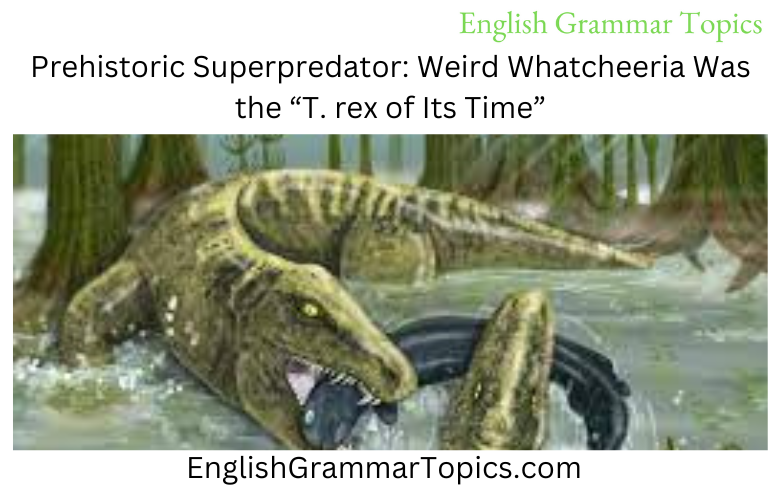There have been about 350 Whatcheeria specimens discovered, ranging from single bones to entire skeletons, and each one is housed in the Field Museum’s collections. These specimens were used in a recent study that was published on November 28 in the journal Communications Biology to help explain how Whatcheeria grew large enough to threaten its fishy prey: it grew quickly in its youth rather than “slow and steady” like many contemporary reptiles and amphibians do.
According to Ben Otoo, co-author of the study and PhD candidate at the University of Chicago and the Field Museum, “If you saw Whatcheeria in life, it would probably appear like a huge crocodile-shaped salamander, with a narrow head and plenty of fangs.” It could fit in your bathtub if it really curled up, possibly to an uncomfortable degree, but neither you nor it would desire that.

Because Whatcheeria was a top predator, this is the case. Its robust leg bones may have helped it to stay put and wait for prey to swim past. Bony grooves in its cranium for sensory organs shared by fish and aquatic amphibians suggest that it lived underwater.
It most likely would have spent a lot of time close to the bottom of lakes and rivers, lunging out and consuming whatever it pleased, according to Otoo. You could absolutely refer to this as “the T. rex of its time.”
Whatcheeria is a “stem tetrapod,” an early four-legged creature that is a part of the lineage that eventually evolved into the four-limbed creatures that are alive today, despite looking like a huge salamander.
Whatcheeria does not belong in those contemporary groupings, according to Ken Angielczyk, a curator at the Field Museum and co-author of the study. “Whatcheeria is more closely connected to current tetrapods like amphibians, reptiles, and mammals than it is to anything else,” he says. “That implies it can teach us about the evolution of tetrapods, including us.”
Because there are so many Whatcheeria specimens in the Field, researchers may use them to study the animal at various stages of its life. According to Angielczyk, “most early tetrapods are known from just one skeleton, if you’re lucky — in many cases, just a fragment of a single bone.”
However, because the Field is home to such a large number of animals, scientists have been able to identify variation within the species: some Whatcheeria are as large as six and a half feet, while others are much smaller. That implies that it was possible to research their growth.
According to Megan Whitney, the study’s lead author and a professor at Loyola University in Chicago who started working on the project at Harvard University, studying these fossils is similar to reading a book, and the researchers are attempting to read as many chapters as they can by observing how juveniles develop leading up to adulthood.
We chose to focus on the species Whatcheeria and examine its life history at various phases because of where it is located in the early tetrapod family tree.
Otoo and Angielczyk offered up the thigh bones of nine Whatcheeria individuals, ranging in age from juvenile to adult, to observe how the species grew. Stephanie Pierce from Harvard University, Whitney’s advisor, and she used tiny slices of bone to analyse under a microscope. Every growth season, an animal adds new layers of bone, according to Otoo.
They say that the animal may exhibit a seasonal pattern in which it grows rapidly in the spring and summer, stops growing in the winter, and then picks up again in the next spring. You can tell if an animal is growing constantly throughout its life, perhaps with a few brief stops, or if it basically reaches adult size before stopping by looking at how thick the growth rings are over the course of its life.
Some modern tetrapod creatures, including birds and mammals like ourselves, develop rapidly as juveniles before ceasing to grow as adults. Other creatures, including crocodiles and many amphibians, on the other hand, continue to develop slowly throughout their whole lives.
Whatcheeria was predicted by the researchers to grow “slow and steady,” more like reptiles and amphibians. But after looking at the bone slices, Whitney discovered proof that Whatcheeria first expanded quickly before slowing down over time. She even discovered fibrolamellar bone, a main bone tissue linked to quick growth.
Whitney recalled saying, “This breaks all of the rules we thought of for how growth is evolving in these early tetrapods” while hopping on Slack with Stephanie Pierce.
The finding sheds light on several aspects of Whatcheeria’s daily life. Being large and a top predator gives you an advantage over other predators because it’s easier to hunt other animals and more difficult for them to hunt you, according to Pierce.
When living in unpredictable environments like the lake system Whatcheeria inhabited, which experienced seasonal dying periods, it can also be a useful survival strategy.
The trade-off is that extremely rapid growth consumes a tremendous amount of energy, which can be problematic if an animal’s needs for food and resources are not being met. Just as it is simpler to make smaller monthly rental payments than it is to save up for a sizable down payment on a home, it is also simpler to obtain just enough food to grow a little bit.
Researchers say the results serve as a reminder that evolution is a series of experiments rather than a tidy, stepwise process and help us understand the evolutionary pressures on early tetrapods.
According to Angielczyk, evolution involves experimenting with various lifestyles and feature combinations. “As a result, you get an early tetrapod animal like the Whatcheeria, which is also one that grows quite quickly. For its period, it is incredibly significant.
It has this peculiar skeleton that may allow it to accomplish feats that some of its contemporaries were unable to. It demonstrates the diversity of life on Earth both then and now and is an experiment in how to be a large predator.
